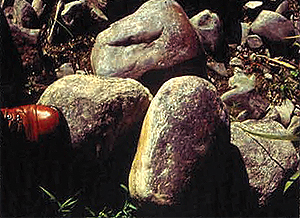A Sense of Place: “That Glaciated Feeling”
I looked at the boulder in front of me and I was feeling thrill like a child. I am a naturalist and I often find pleasure in some of the simplest facets of nature. “Well, you’re not from around these parts, are you?” I said to myself as I leaned over to feel the boulder’s smooth surface. I admired the flecks of black and pink crystalline structure in the stone. This was a chunk of granite and it was formed eons ago and hundreds of miles north of where I stood in Crawford County.

Glacial boulders from French Creek.
Seeing the glacial erratic boulder made me think back to the neighborhood workshop I led years ago at Lake Pleasant. I was attempting to describe the glacial landscape of Northwestern Pennsylvania. I was trying to impress upon the audience the tremendous influence of continental glaciers and just how massive the ice sheets were that molded that setting. I grabbed several helium balloons that were tied together and a spool of fishing line. I invited the audience to follow me outside. We stood in a field and watched as the balloons rose skyward and the spool spun around.
Geologists say that the Wisconsin ice sheet 20,000 years ago was a mile thick in places. That’s impressive, but how can we imagine that? I only had a quarter of a mile of line that represented the thickness of the ice mass. The balloons helped get the message across.
Every landscape has its own signature characteristics, and when we discover them like I did with the boulder, we develop a sense of place. Whenever I travel north from Pennsylvania’s southwestern plateaus and cross into the glaciated section, I am reminded of its unique characteristics. The low rolling hills, broad U-shaped valleys, abundance of sugar maples and frequent wetlands; I am in a different setting with its own character and personality. The northwest region gives me a “glaciated feeling,” resulting from a time when this land was covered by ice.
Beyond the gross landscape features, I can focus in on specifics, like the granite boulder, formed somewhere in Canada and then picked up by the glacier, rounded off, polished smooth and transported way south of its origin. Many stream beds in this region are great habitats for freshwater mussels and other aquatic life. They are composed of sand and pea gravel of similar origin that makes it easy for the mussel to burrow. There is a lot of limestone in this glacial landscape’s soils. The stark beauty of the pink and white showy lady’s-slipper orchid, a wetlands species, is found almost exclusively in these northwest glacial counties.
As you travel around you might enjoy developing a sense of place, recognizing particular plants and animals, and by learning a landscape’s geologic history.
